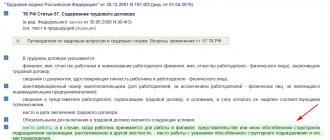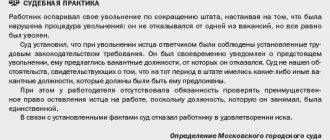15.08.2019
0
35
4 min.
Going on vacation is a procedure that is implemented in accordance with the established procedure. The Labor Code at the legislative level guarantees the right to annual rest for a period of 28 days. But to receive it, the employee must work for a certain period of time. Article 121 of the Labor Code of the Russian Federation provides information on the calculation of vacation experience.
The concept of special experience
Some types of work, professions, specialties and areas of activity are characterized by a different procedure for granting leave. This is often due to specific conditions for the implementation of labor functions. A number of benefits are provided for such categories.
Calculation of special experience is typical for:
- Civil servants;
- Employees of the Ministry of Emergency Situations, FSB, Ministry of Internal Affairs and similar departments;
- Citizens employed in enterprises with harmful or dangerous conditions;
- People working in regions with difficult climate and living conditions;
- Test pilots, cosmonauts;
- Military personnel;
- Medical workers;
- Teachers.
The presented categories have the right to early retirement, long-service payments, and material bonuses. Also, the specific nature of the work affects vacation time. The listed groups of workers are entitled to extended rest. The period is determined based on the length of service.
The right to benefits is granted only if the citizen has documents confirming the special status of his work. These include both employee IDs of a certain service and a work book.
Article 121 of the Labor Code of the Russian Federation. Calculation of length of service giving the right to annual paid leave
1. The right to annual paid leave arises from the first day of work, but to receive this leave you must have a certain length of service with a given employer. Only with such length of service does the employee have the right to demand leave, and the employer is obliged to provide it.
The length of service giving the right to receive leave is calculated in the manner established in Article 121 of the Labor Code of the Russian Federation.
The basis of the length of service for receiving annual paid leave and its largest part is the time of actual work, i.e. the period during which the employee actually performed the job duties assigned to him (and job duties can also be performed outside the place of permanent work, for example, on business trips).
The rule on including actually worked time in the vacation experience did not previously apply to persons serving a sentence in the form of correctional labor at the place of work. Persons sentenced to correctional labor were not granted annual leave while serving their sentence at their place of permanent work, and the period of serving correctional labor was not counted towards the length of service giving the right to leave. Currently, in accordance with Part 6 of Art. 40 of the Penal Code, during the period of serving correctional labor, a convicted person is granted an annual paid leave of 18 working days by the administration of the organization in which he works, in agreement with the penal inspection. Other types of leave provided for by the labor legislation of the Russian Federation are provided to convicted persons on a general basis.
2. When calculating the length of service for vacation, the time when the employee did not actually work is also taken into account, but beyond him in cases provided for by labor legislation and other regulatory legal acts containing labor law norms, a collective agreement, agreements, local regulations, an employment contract, the place of work (position) was maintained. Part 1 of the commented article specifically states that when calculating the length of service for vacation, the time of annual paid leave, non-working holidays, weekends and other rest days provided to the employee are also taken into account.
Employees retain their place of work (position) even in cases where, in accordance with labor legislation, they are involved in the performance of state or public duties. For example, while attending military training, medical examination, examination or treatment related to military registration; participation in the work of election commissions; appearing when summoned to the bodies of inquiry, preliminary investigation or court as a witness, victim, expert, specialist, translator, attesting witness; participation in court hearings as a juror; study leaves; training, advanced training and retraining of workers away from production and while maintaining their place of work (position); the employee’s presence in a medical institution for examination, if he is required to undergo it due to his occupation; exemption from work for donors to donate blood and subsequent days of rest; suspension of work by bodies of state supervision and control over compliance with labor legislation and other regulatory legal acts containing labor law norms due to violation of labor protection requirements through no fault of the employee. These periods are also included in the length of service giving the right to annual basic paid leave.
3. The length of leave for leave in accordance with Part 1 of the commented article includes the period of suspension from work of a person who has not undergone a mandatory medical examination (examination) through no fault of his own, and the time of forced absence in the event of illegal dismissal or suspension from work and subsequent reinstatement at work (see commentary to Articles 76 and 394). Although the commented article does not say anything about those cases when an employee had forced absenteeism due to an illegal transfer to another job, it should be assumed that this period, if the employee was reinstated at his previous job, is also included in the length of service giving the right to an annual paid vacation.
The length of service that gives the right to annual basic paid leave also includes the time of unpaid leave provided at the request of the employee, not exceeding 14 calendar days during the working year. In other words, if the total (summed up) duration of vacations granted to an employee during the working year is 14 calendar days or less, then the entire actual time of these vacations is included in the length of service. If the total duration of such vacations during the working year exceeds 14 calendar days, only 14 calendar days are included in the length of service. So, for example, if during the working year an employee was granted leave for 10, 4 and 8 calendar days (a total of 22 calendar days), then only 14 calendar days will be included in the length of service giving the right to annual basic paid leave.
4. Collective or labor agreements, as well as local regulations, may establish other periods of time, in addition to those listed in Part 1 of Article 121 of the Labor Code of the Russian Federation, included in the length of service giving the right to annual basic paid leave.
5. Part 2 of the commented article establishes an exhaustive list of periods of time when an employee is absent from work, which are not included in the length of service giving the right to annual basic paid leave, including:
- time of absence from work without good reason (for example, days of absenteeism without good reason, being in custody for committing petty hooliganism);
- time of absence from work due to suspension from work in cases provided for in Art. 76 of the Labor Code, if the employee is suspended from work due to his own fault (for example, if he appears at work in a state of alcohol, drug or other toxic intoxication, if the employee has not undergone a mandatory medical examination or training and knowledge testing) (see comment. to Art. 76);
- time of leave to care for a child until he reaches the age established by law (see commentary to Article 256 of the Labor Code, Part 2 of Article 257 of the Labor Code).
When summing up unpaid leave in accordance with the new rules, it does not matter for what purpose the employee requests such leave (for family reasons, for child care in accordance with Article 263 of the Labor Code, rest, travel). It also does not matter the category of employees who applied for such leave (pensioners, disabled people, parents of military personnel who were killed or died as a result of injury, concussion or injury received during military service, etc.). When determining the duration of unpaid leave granted to an employee during the working year, such leaves are also taken into account that the employer, in accordance with the Labor Code, is obliged to provide to the employee, for example, to working old-age pensioners and disabled people (see commentary to Article 128).
6. When calculating length of service giving the right to basic annual paid leave, the length of the working day and working week does not matter. Persons employed part-time receive annual basic paid leave under the same conditions as those performing similar work with normal working hours. Only the amount of payment for vacation time will be different for them (see commentary to Article 93).
7. Part 3 of the commented article establishes the features of calculating length of service, which gives the right to annual additional paid leave for work with harmful and (or) dangerous working conditions.
If the length of service giving the right to annual basic paid leave, in addition to the time of actual work, includes some other periods provided for in Part 1 of the commented article, then when granting the specified additional leave, only the time actually worked in the relevant industries and in work with hazardous and (or ) hazardous working conditions.
At the same time, the time worked in production, workshops, professions and positions with hazardous working conditions is counted only those days on which the employee was actually employed in these conditions for at least half of the working day established for employees of a given production, workshop, profession or positions (paragraph 1, clause 12 of the Instruction on the procedure for applying the List of industries, workshops, professions and positions with hazardous working conditions, work in which gives the right to additional leave and a shortened working day, approved by the Resolution of the State Labor Committee of the USSR and the Presidium of the All-Union Central Council of Trade Unions of November 21, 1975 N 273/P-20).
It should be noted that in connection with the entry into force of the Labor Code, the legality of applying the rule on including only the time actually worked in these conditions in the length of service giving the right to annual additional paid leave for work in harmful and (or) dangerous working conditions has been questioned . However, the Supreme Court of the Russian Federation, when considering civil cases based on statements by Nozhkov A.A. (decision of the Supreme Court of the Russian Federation dated February 6, 2002 N GKPI2002-30) and the unitary enterprise "Chelyabgortrans" (decision of the Supreme Court of the Russian Federation dated April 15, 2004 N GKPI2004-481), based on an analysis of Art. 117 and part 3 of article 121 of the Labor Code of the Russian Federation, recognized the requirements of paragraph. 2 clause 8 and para. 1 clause 12 of the said Instructions by the relevant Labor Code.
As stated in the decisions of the Supreme Court of the Russian Federation, an analysis of this norm does not allow us to conclude that an employee acquires the right to additional paid leave regardless of the duration of work in hazardous working conditions, since the law specifically stipulates that the conditions for providing this leave are approved by the Government of the Russian Federation, taking into account opinions of the Russian Tripartite Commission for the Regulation of Social and Labor Relations. Since at present the regulatory act on the conditions for providing additional leave by the Government of the Russian Federation has not yet been adopted, in accordance with Part 1 of Art. 423 of the Labor Code on the issue under consideration, the contested Instruction continues to be in force. Confirmation of the conclusion that the contested prescription of the Instruction complies with the Labor Code is also part 3 of Article 121 of the Labor Code of the Russian Federation, which provides that the length of service that gives the right to annual additional paid leave for work with harmful and (or) dangerous working conditions includes only the work actually worked in appropriate conditions time.
Along with this, when considering the application of the municipal unitary enterprise "Chelyabgortrans", the Supreme Court of the Russian Federation found some other provisions of the Instruction on the procedure for applying the List of industries, workshops, professions and positions with hazardous working conditions, work in which gives the right to additional leave and shortened work, to be inconsistent with the Labor Code day.
In particular:
- para. 3 clause 8, which provides that the length of service giving the right to additional leave to the specified employees also includes: a) a period of temporary disability; b) the time of maternity leave, the time women perform light work in connection with pregnancy, as well as the time women perform other jobs to which they were transferred due to breastfeeding or the presence of children under one year of age; c) time for performing state and public duties;
- the fifth sentence of clause 9, containing an indication that in cases where an employee’s right to annual (main) and additional leave arises at different times, then these leaves are provided to him simultaneously and in full;
- indication in paragraph. 3 examples to clause 9 of the Instruction that if annual (main) leave is provided in advance, then additional leave must also be provided in advance and in full;
- indication in the third sentence of paragraph. 4 examples to paragraph 9 that when going on vacation, a worker, along with annual (main) leave, must be given additional leave in full.
At the same time, the Supreme Court of the Russian Federation recognized the provisions of paragraph 10 of the said Instructions as not contradicting the Labor Code, which provide for the procedure for calculating length of service giving the right to additional leave for work under hazardous working conditions, in proportion to the time worked in these conditions. As stated in the decision of the Supreme Court of the Russian Federation, the Labor Code does not establish a mechanism for calculating length of service giving the right to additional leave. Paragraph 10 of the Instructions defines this procedure and is subject to application by virtue of Part 1 of Art. 423 TK.









